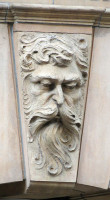
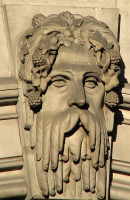
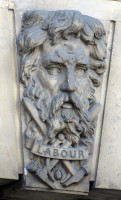
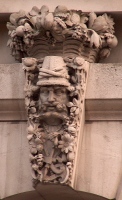
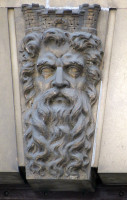
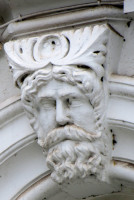
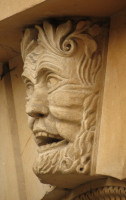
Keystones are among the most frequently found types of sculptural ornament to architecture, and among keystones, the bearded head is perhaps the most commonly found type. An architect in 18th or 19th Century Britain would often be seeking sculpture which would emphasise concepts such as solidity, constancy, permanence, and a male, bearded head of a mature age was ideal for this. As with figure sculpture, we can find symbolical representations of particular concepts such as Justice and Labour - see third example from left above - but much more usual are pagan gods of the water and the forest. The archetypical type of the water god is the Greek Poseidon of the Sea, Neptune for the Romans, and for Britain, surrounded by water and long dependent on its navy, there has always been an appeal to symbols of the sea. In the contemporary literature describing buildings put up in the 19th Century, we may occasionally come across references to the keystone heads representing particular great rivers, but in practice, there seems to be no agreed identifiable type for the Thames, Mersey, Avon and other rivers, so that there is little satisfaction in being told that a particular head is meant to be a particular river.
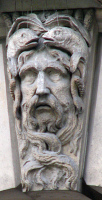
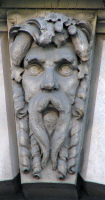
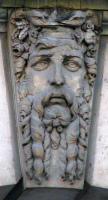 Somerset House keystone heads.
Somerset House keystone heads.
What, then, do we see in our keystones showing River and Sea Gods? Here are three, from Somerset House in London on the Strand, chosen as early examples of the type on an important palatial building, which would have been examples to inspire later sculptors. The immediate impact of these works is that they are serious sculpture, far beyond simply ornament, with a strength and conviction by the artist which cannot be dismissed. Although varied, they share three features: All the faces are mature, with bony, haggard faces, heavy brows, lines on forehead and lines under the cheeks. We notice the beards, complex and varied, difficult to imagine ever encountering, or that anyone but the most great ancient king would have such a beard, and only then on a formal occasion. And then we notice the hair, with fish and shells and leafy vegetation; although the idea of someone with a fish in their hair is intrinsically absurd, the sculptor carries the idea off with aplomb, and all three examples look convincing. It is these three features – the older faces, the beards, and the hair and what is within it, that we will consider in looking at bearded keystone heads.
Here are more examples. Above left, a keystone head with a rather conventional wavy beard, and two Roman dolphins in his hair, outward facing. Then a keystone with a particularly strange beard, as if separate hanging ‘columns’ of hair, a type which we shall encounter once more, again dolphins in the hair, and a shell. The third example is mid-Victorian, and shows a different sort of face, more Kingly than Godlike, somehow, with a crown bearing a variety of seashells, and a beard which is a mass of fine-lined detail of the hair, with tiny dolphins swimming within it (you will need to click to enlarge the image to see these).
Here we have a type which is a particular favourite of mine – the hoary, seaweedish type. Above left, we see an elderly, careworn river god with eels in his hair, and long eyebrows. The centre personage takes this a step further, with its look of bedraggledness, the eyes almost lost in the depths of their sockets. And to the right, the figure is as if his hair and beard were falling water which have frozen as icicles, a truly remarkable creation.
We return to beards. Above are examples of another type, where two parts of the beard, to left and right, are braided together in the fashion of a chollah bread. The first on the left appears as some fierce almost oriental king, perhaps, with his high cheekbones, curls to the tips of his hair, and crown with a shell and the billowing sails of two ships. (If you like ship sculpture, see this page.) As well as the braided strands of beard to left and right, a central double section is tied together. Then a rather similar example in the treatment of the beard, but with seaweed above, and a single central fish lurking within it. Then another scowling example, where there are side braids but hardly any central portion, thus a forked beard; he also sports thistles and some other flower in his hair. Above right, the outer braids are particularly elegant, and there is a twisting central group, thus a triple beard.
The forked beard where the two parts are crossed over each other is also not uncommon. A straight-forward example is above centre,where left and right strands of the beard are crossed over some central portion hanging almost straight. To the left, a lugubrious personage with the two forks crossing just under the chin, and themselves each made of pairs of strands coiled around each other. He appears to have some ball in his open mouth, something not unusual in carved lion’s heads, but extremely so in human heads. Flowers and fruits form the crown of this characterful example. And to the right, another splendid example, very fishy, with long hair down to the sides oozing with eels, and a double crossing of the forked beard.
The examples above are of the ringletted beard type; these are fairly common, and allow harmonious spirals and repeating patterns which give good decorative effect. The outermost examples to left and right are naturalistic ringlets; the three inner keystone heads have varying degrees of a more ornamental treatment.
Here are examples of a more naturalistic type of beard, finely lined. Firstly, a cases of a woolly beard, quite exaggerated in effect. Then, in the centre, a reminder that bald, or balding, bearded keystone heads are also found, though by no means usual. The keystone head on the right is particularly ornamental, with beard and hair spreading outwards, similarly to the effect of a girl’s long hair when she floats face upwards in water - think of Waterhouse's The Lady of Shalott.
But the most common type of beard, as for hair, has simple, short strands bunched together in leaf or almond shaped bunches. Variations on the theme are shown in the row above – but there are many more possibilities.
The last one of that row of the ‘standard’ type of beard, set against a leafy surround, reminds us of one further type of beard sometimes found on keystone heads, which is where the beard itself is stylised in leafy form. A few are shown above. They are not uncommonly found in cast iron bearded heads, as in the first and third examples, and in the extreme, as in the fourth example, above right, look like the ‘green man’ sometimes found on medieval churches as a recollection of pagan worship.
I think that will do for our consideration of the beards of our bearded keystone heads. Now to the second area of variety, which is the content of the hair. We have already covered the sea-creature and shell school of keystone heads, associated with ocean and river gods, and so particularly evocative in Britain with its maritime traditions. Equally evocative, of a semi-mythological past of druids and sacred groves of Celtic times, are the forest gods. The series above show variations on the oak leaf and acorn, which as well as its ancient symbolism, appeals to the viewer with its implications of strength and endurance.
Other leaves are often found. Above left, we have spiky thistles forming a rather nice coronet. Then Ivy, symbolic of memory, and also evocative of the times of the druids. Then what looks to be a crown of olive leaves and fruit, more commonly found as a wreath indicating peace. And then an example of a sort of loosely palm tree type leaf, found not infrequently, and equally likely to be indicative of broad-leaved grasses or rushes.
More leaves above. These keystone heads could all do service as minor gods of forest and harvest. The treatment of the leaves varies from the formal (far left), to the broadly symmetrical, to the asymmetrical but balanced composition. In these examples, that same far left keystone head is a noble Roman, the second might be Greek, the third could be a wild satyr, the next two seem more Celtic, and the far right could be Saxon in physiognomy.
Before moving on from leaves, we should let our keystone deities plunge back into the water, where as an alternative to fishy accoutrements, it is not uncommon to have the bulrush as an indication of a fresh water river god. Above left, a typical example with full bulrushes in his hair and a particularly swirly beard. The second has more leaves, and a ringletted beard. Next an example with more bulrush and less leaf, on a keystone head with plaited and ‘finger’ beard design. And to the right, an example where the bulrushes lean inwards to form almost a circlet across the brow – his beard is swirly and suggestive of waves. To the furthest right, the profile view emphasises the crown-like structure of the bullrushes, on a kingly rather than godlike keystone head.
Fruits next. Above left, a sort of harvest festival keystone head, a god of the harvest and fruitfulness perhaps, appropriate equally for a store or a bank or an insurance office. We see a variety of soft fruit, and two sweetcorn cobs at the back, above a rather fierce visage. Then a rather crunchier example, with sunflower seeds formed into a central star, a cone and various hard, knobbly fruits, along with a single pear – a good composition. The third face above, with particulary frondy moustaches, has corn as well as hard and soft fruit in this hair. And to the far right, a sombre, sardonic god with flowers, corn and grapes forming a magnificent symmetrical headdress.
A special place should indeed be reserved for the vine, and three more examples of vinous keystone heads are above, showing the focus can be on the bunches of grapes or the entwining foliage. Ideal for a place of entertainment such as a club or tavern, these are not faces of Bacchus – who would be plumper and generally beardless, but evoke a wildness and pagan bohemianism.
And another special place is needed for corn, of which examples are above. Abundance, fruitfulness, the paternalistic provision of nourishment to the people, as might befit a town hall, are all suggested. And still a paganism, a link to the earth and all that is good within it – what could be more wholesome than the rearing and harvesting of corn?
Animals, other than sea creatures, are not so common, and are always a treat when found. Who could resist the sheep’s head of the centre example? Rather flat, with horns looping extravagantly round to hold locks of hair, this is an inspired design. In the centre, another remarkable composition, where we seem to have a cat’s head, with rather batlike ears – the suggestion of a bat is added to by the winglike structures at the side. Rather a good Celtic knot design hair below, small flowers above the ear positions, and a woven strandlike beard; unusually, mouth and chin are here exposed. And to the right, two fierce little animals of mythology, somewhat griffinlike, with wings crossed in the centre, providing both a frame for the head and a pleasing echo of the two bunches of hair covering the forehead below.
The lion page on this site depicts examples of keystones where there is a headdress in the form of a lion’s head with wide open mouth. Two more examples are above.
Birds in the hair of keystone heads are less common than lions, but above are examples.
Above left, a pair of doves peak coyly out from the sides, each with a wing spread towards the centre.
Then an odd one – two swans lie across the top of the head, their necks down as if sleeping.
They are surrounded with fruit and corn cobs are at the rear, and may represent game rather than live birds.
A single bird crowns the thick hair of the third example, wings outstretched in Hermes-like fashion, though this keystone head is no Hermes.
And although it is a beard case rather than a hair case, I cannot resist including the dead bird, surely game,
in the example to the far right, which is from the P&O Building in
The wings above the head bring us to gods with wings in their hair – again, the example above left is not depicting Hermes though,
as although that god has wings on his helmet, he has no beard. Then three examples of keystone heads with head coverings: a ringletted bearded keystone head with a helmet,
bearing a small lion’s head, and another helmeted head, with higher up, a vast array of fruit and flowers.
We also see an Arabic chieftain with a headdress.
Crowns denote kings, thus wealth and richness, and so keystone crowned heads are particularly appropriate for banks
and great trading houses. Bearded keystone heads with crowns generally have the look of great kings rather than gods,
though this is by no means a rule, as exemplified by the head above second left, where the crown is something of a trident,
and thus we probably see a head of Poseidon. Then a rather flowery, modernish crowned king, which it is hard to take seriously.
Next, an Eastern-style ‘puffed up’ crown, and then a traditional, rather simple rendition of a crown on a good, characterful face.
To exemplify a different type of crown, see also the rather rounded, very eastern or Assyrian kinglike face, with carefully curled beard, ringlets over the forehead,
and a delicate crown of fabric. The outermost examples wear different, but still familiar types of crown.
More directly evocative of riches is the cornucopia, the horn of plenty filled with good things or showering coins from its bowl.
The example above left has two cornucopias almost like a Satyr’s horns, filled with coins; the one to the right has the coins
spilling out of the cornucopias, and under the beard, a rolled up scroll with hanging coins, or perhaps counting beads.
We end with a few other, exotic types. Below left, a rather less hairy example of a bearded keystone head,
perhaps a satyr (for various examples of satyr sculpture, see this page).
Then an Assyrian king with ornamented headdress, well composed. Next, a simple example with moustache and merely a goatee beard,
some sort of troubadour, to give an example of a bearded keystone which represents neither king nor god.
And to the right, perhaps another eastern potentate, out of Assyria or Etruria.
Visits to this page from 13 Mar 2014: 19,698
Introduction to keystone sculpture // Female head keystones // Architecture pages // Sculpture pages